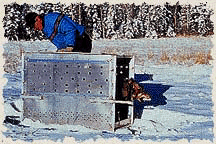Exactly six years and one day after helping release the first wolves into Yellowstone Park, Interior Secretary Bruce Babbitt bid farewell to a packed crowd at Mammoth Hotel this past Saturday.
However, his visit was more than a farewell gesture. It was also a plea for ranchers to stop their campaign against wolves and other animals that graze outside of the park.
“If ranchers know what’s good for them, they won’t try to force wolves and bison from public land where cattle also graze, because that’s a battle they can’t win,” Babbitt told the crowd. “The American public won’t stand for it and if the beef industry forces a confrontation, it will lose.”
He said the farmers and ranchers should respect the importance of maintaining a natural ecosystem where wild animals are allowed to roam free.
“The grazing of livestock will and must be subordinated to the natural values, including the bison and the predators, who will and must have first place in the ecosystem,” Babbitt said. “There are ways for livestock and wild animals to use the same piece of ground. It’s been proven in many places and livestock owners won’t be forced off public land unless they force the issue. It doesn’t have to be either/or, but if the livestock industry says it has to be either/or, the choice will be made in favor of wolves.”
The message was well received with a standing ovation by the mixed crowd. The event included a presentation by Yellowstone Park Superintendent Mike Finley. He said the wolf reintroduction has been a success.
“The reintroduction of wolves into Yellowstone is a celebration, and rights a wrong which was started in 1914 by Congress to eradicate the wolf,” Finley told the crowd. “The reintroduction also focuses on something that Secretary Babbitt has supported and that is restoration and ecology. Restoration does work and can work. This is a prime example. All available species, that were present when Europeans first landed on North America are present and interacting now here in Yellowstone today.”
Likewise, since their reintroduction, wolves in Yellowstone have continued to prosper.
“The wolves have reproduced and today there are between 164 and 169 wolves in the Yellowstone ecosystem,” said Doug Smith, the park’s top wolf biologist. “That’s 16 packs, and 11 breeding pairs, which is a tremendous success. The wolves in Yellowstone are in extremely good condition, and every one we handle is fat.”
One yearling wolf in particular weighed 115 pounds . The average adult Alaskan wolf in the wild weighs 100 pounds. Doug said.
“I think that in twenty five to thirty years from now, the Yellowstone ecosystem will look very differently,” Smith told the audience. “In a positive and beneficial way.”
About 90% of the wolves diet consists of elk and the elk herd continues to increase despite the wolves presence. “The Yellowstone ecosystem also is unique in that it has 6 major carnivores, wolves, grizzly bears, black bears, coyotes, mountain lions, and humans. There are only 1 or two other locations in North America with that array of predators,” he said.
A new study dubbed “food for the masses” which focuses on how wolf kills affect other wild life in the park, “Indeed, I wonder what a raven did in the winter before the wolf showed up” Smith told the laughing crowd. “Ravens are following wolves around to kill sites and the longest it takes a raven to find a kill is about 30 seconds.”
The wolves have impacted the park from the ungulates and scavengers, to the humans. “About 70,000 visitors have viewed wolves in the park since 1995” Smith said.
After the morning presentation, Babbitt and about 25 other people, mostly journalists were treated to a wolf viewing tour into the northern range of the park. The first location was a recent kill site where the Rose Creek pack had made a kill earlier that morning. But by the time everyone arrived, the pack had left the area leaving us with coyotes and ravens to watch.
The entourage then packed up and traveled farther up the valley near Soda Butte where the Druid Peak pack had made a kill earlier in the night. Although the pack had moved into the timber by the time Babbitt arrived, a grizzly bear had been spotted near the kill site digging in the ground by Rick McIntyre and his field crew.
Seeing Grizzly bears out of hibernation during the winter is not an unusual occurrence, especially during mild winters. During the last couple of winters, people have noticed a slight increase in grizzly bears out of hibernation feeding at wolf kill sites.
Babbitt, 62, said now that “I’m toast in 7 days. I plan to write a book that draws upon my experiences to outline my vision of what the future will look like. The success of the wolves is just the beginning. The message up here is that we’ve made a hell of a start.”

